
La Palma, also San Miguel de La Palma, is the most north-westerly island of the Canary Islands, Spain. La Palma has an area of 708 square kilometres (273 sq mi) making it the fifth largest of the seven main Canary Islands. The total population at the start of 2019 was 82,671, of which 15,716 lived in the capital, Santa Cruz de la Palma and about 20,467 in Los Llanos de Aridane. La Palma has "sister city" status with El Dorado Hills, California. Its highest mountain is the Roque de los Muchachos, at 2,423 metres (7,949 ft), being second among the peaks of the Canaries only to the peaks of the Teide massif on Tenerife.

Argyranthemum is a genus of flowering plants belonging to the family Asteraceae. Members of this genus are sometimes also placed in the genus Chrysanthemum.
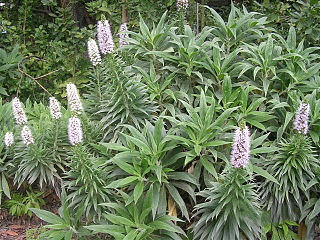
Echium virescens is a flowering plant in the genus Echium. It is endemic to the island of Tenerife, mainly in Macizo de Anaga and the Orotava Valley. It grows in forests and on lower south slopes of the island.

Echium is a genus of approximately 70 species and several subspecies of flowering plant in the family Boraginaceae. The type species is Echium vulgare.

Echium wildpretii is a species of flowering plant in the family Boraginaceae. It is an herbaceous biennial plant that grows up to 3 m (10 ft) in height. The species is endemic to the Canary Islands, and is found mainly in Las Cañadas del Teide. The subspecies E. wildpretii subsp. trichosiphon occurs at high altitudes on La Palma. The common names are tower of jewels, red bugloss, Tenerife bugloss or Mount Teide bugloss. The Spanish name for this plant is tajinaste rojo.

Teide National Park is a national park located in Tenerife.

Hypericum canariense is a species of flowering plant in the family Hypericaceae known by the common name Canary Islands St. John's wort. It is the sole member of Hypericumsect. Webbia.

Echium pininana, the tree echium, pine echium or giant viper's-bugloss, is a species of flowering plant in the borage family Boraginaceae. It is endemic to the Canary Islands, where it is restricted to the island of La Palma. It is cultivated in gardens of Britain and Ireland, and it has naturalized along the northern California coast in San Mateo and Mendocino Counties. Its native habitat is laurel forests, where it is now endangered through habitat loss.
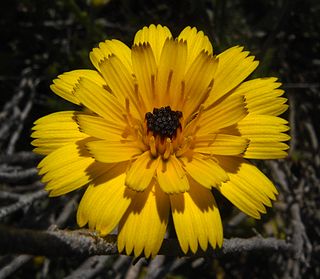
Tolpis is a genus of flowering plants in the dandelion tribe within the daisy family. Many species are limited to the Canary Islands.
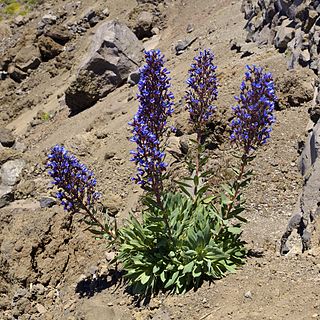
Echium gentianoides is a synonym of Echium thyrsiflorumMasson ex Link., a flowering plant in the borage family Boraginaceae with brilliant blue tubular flowers. It is endemic to the island of La Palma, the Canary Islands. It occurs in one location of La Caldera de Taburiente where it grows in sunny, rocky sites at altitudes higher than 1.800 m. The main threat described for this species is predation by goats and insects.
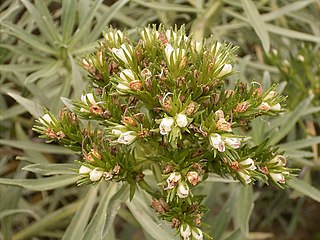
Echium brevirame is a species of flowering plants of the family Boraginaceae. It is endemic to the Canary Islands, where it is restricted to the island of La Palma.

Canarina canariensis is a species of flowering plant in the bellflower family Campanulaceae, commonly known as the Canary Island bellflower, and known locally as bicácaro.
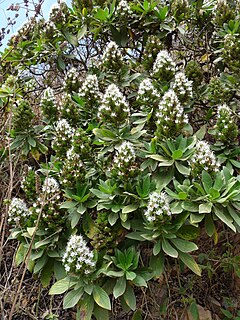
Echium hypertropicum is a species of flowering plants of the family Boraginaceae. The species is endemic to Cape Verde. It is listed as an endangered plant by the IUCN.

Tetraena fontanesii, synonym Zygophyllum fontanesii, is a species of plant of the family Zygophyllaceae. It is found in Macaronesia and northwest Africa.

Echium vulcanorum is a species of flowering plants of the family Boraginaceae. The species is endemic to Cape Verde. It is listed as an endangered plant by the IUCN. The species was first described in 1935 by Auguste Chevalier. Its local name is língua-de-vaca, a name that may also refer to the related species Echium hypertropicum and Echium stenosiphon. The oil of its seeds contains γ-linolenic acid, and is used for medicinal and dietary purposes.

Periploca laevigata is a species of flowering plant in the family Apocynaceae, native to the Canary Islands, the Savage Islands and Cape Verde.

Echium aculeatum is a species of flowering plants of the family Boraginaceae. It is endemic to the Canary Islands, where it occurs on the islands El Hierro, La Palma, La Gomera and Tenerife. Its name in Spanish is ajinajo.

Echium nervosum is a species of flowering plants of the family Boraginaceae. It is endemic to Madeira. The specific name nervosum is from Latin and means "veined".
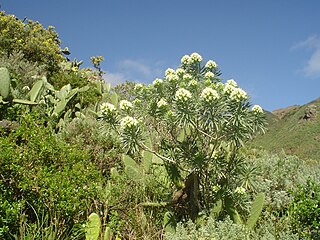
Echium leucophaeum is a species of flowering plants of the family Boraginaceae. It is endemic to the Canary Islands, where it is restricted to the island of Tenerife. Its name in Spanish is taginaste de Anaga. The specific name leucophaeum is from Greek and means "greyish white".
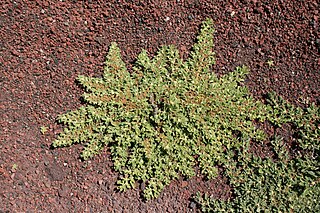
Aizoon canariense is a species of small leafy annual plant in the family Aizoaceae.




















